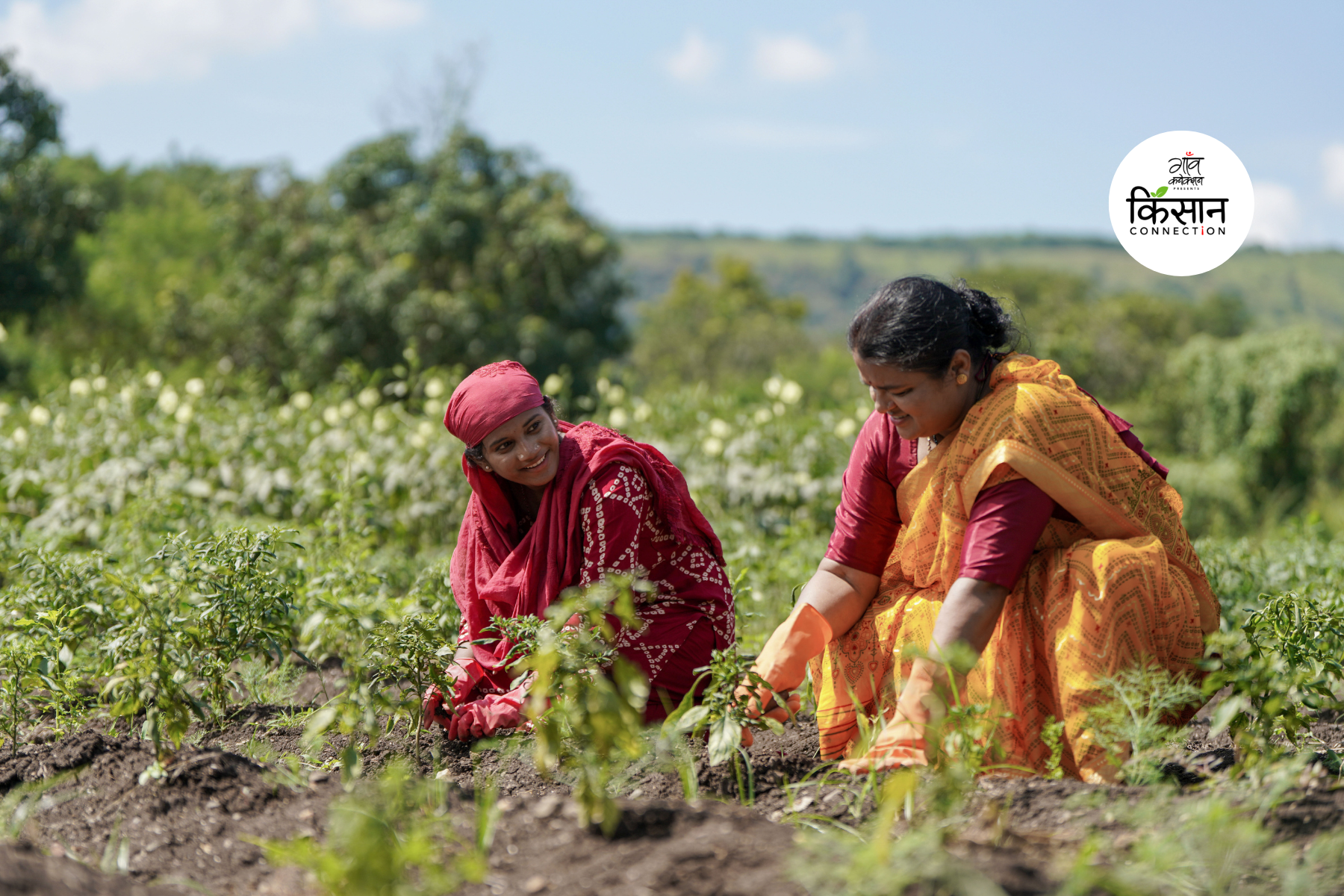Jhansi, Uttar Pradesh
It is 7:30 in the morning and nearly drowning out the bird calls are the raised voices of women. They are arguing about who gets to fill water first. The squabbling continues in fits and starts till at noon, the tap they gather around gurgles, and a trickle of water emerges.
The women scramble to pick up their plastic buckets and steel vessels and jostle to fill them up.
“There is cement, paint. Pipes and taps… but no water,” scoffed Ramsakhi Parihar, a resident of Deli village in Jhansi’s Babina block, located about 340 kilometres from the state capital, Lucknow. “Chahe koi sarkar aa jaye, is gaon ki samasya koi hal nahi kar sakta hai (no matter which government, the problems of this village will never be solved),” she told Gaon Connection.
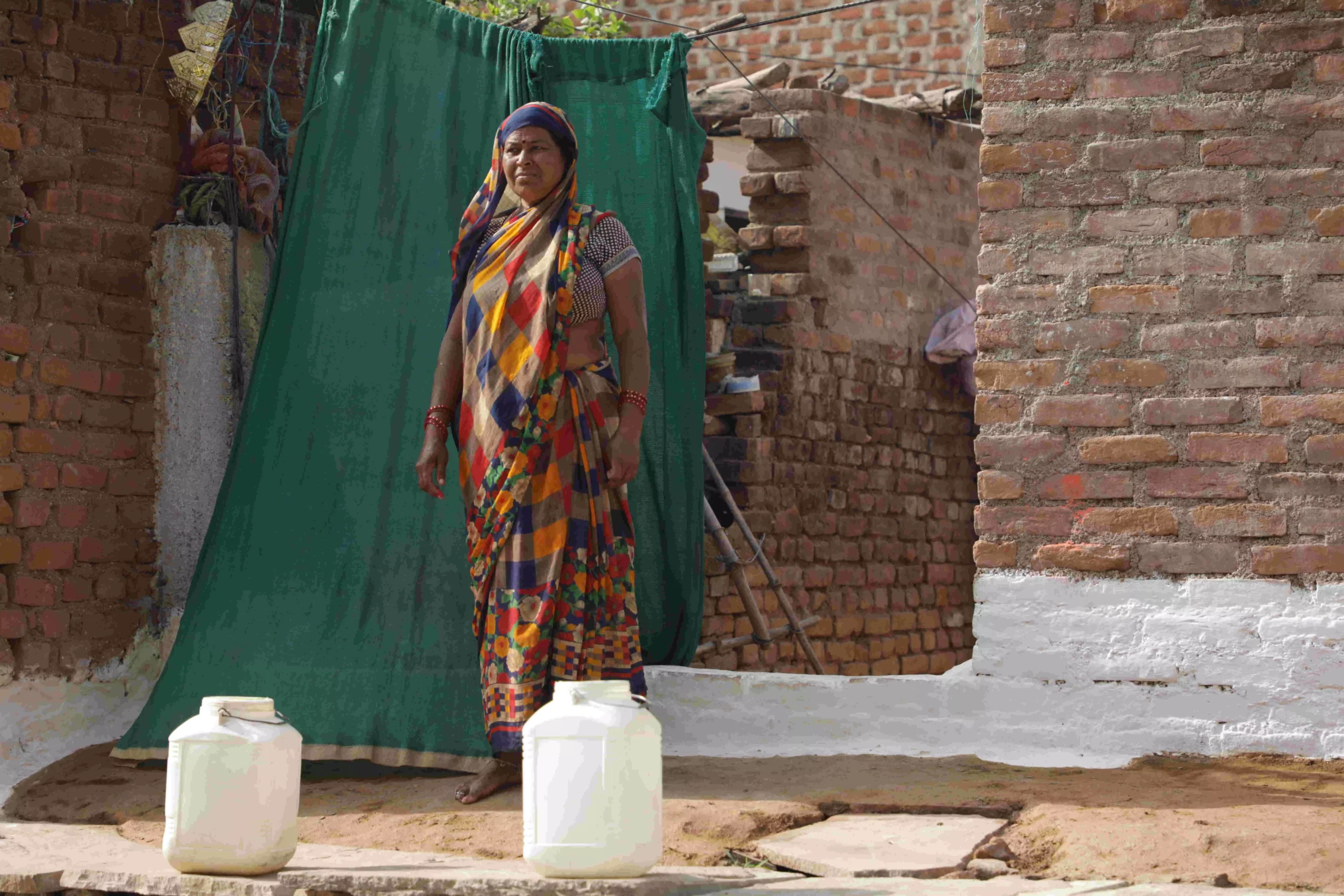
Under the Har Ghar Jal scheme of the central government to provide piped water supply to villages, over five to six months back, pipes were laid and taps installed in Ramsakhi’s village. But, there is no water supply in them. Villagers are forced to spend Rs 100 a month to buy water from a private tap, that also after squabbles and long waiting hours.
About 18 kilometres from Deli village, the situation is similar in Chandra Nagar village. “It has been a month since the pipeline was laid but we are yet to get water. Our day starts by fetching water, and we do it several times a day, and we go to bed worrying about finding water the next morning,” Ashokwati from Chandra Nagar village, with a population of two hundred, told Gaon Connection.
Watch
The woes of Ramkashi and Ashokwati are no different from millions of other rural inhabitants who are struggling to find water in the soaring temperatures. March 2022 was recorded to be the hottest month in the country in the last 122 years, and the early advent of the heatwaves have caught people unprepared. Rural India has always struggled for drinking water in the summers and this year the magnitude of its misery has gone up, as the country struggles with the vagaries of climate change.
India is placed thirteenth among the world’s 17 ‘extremely water-stressed’ countries, according to the 2019 Aqueduct Water Risk Atlas released by the World Resources Institute. A region is said to be under ‘water stress’ when the demand for water exceeds the available volume, or when poor quality restricts water use.
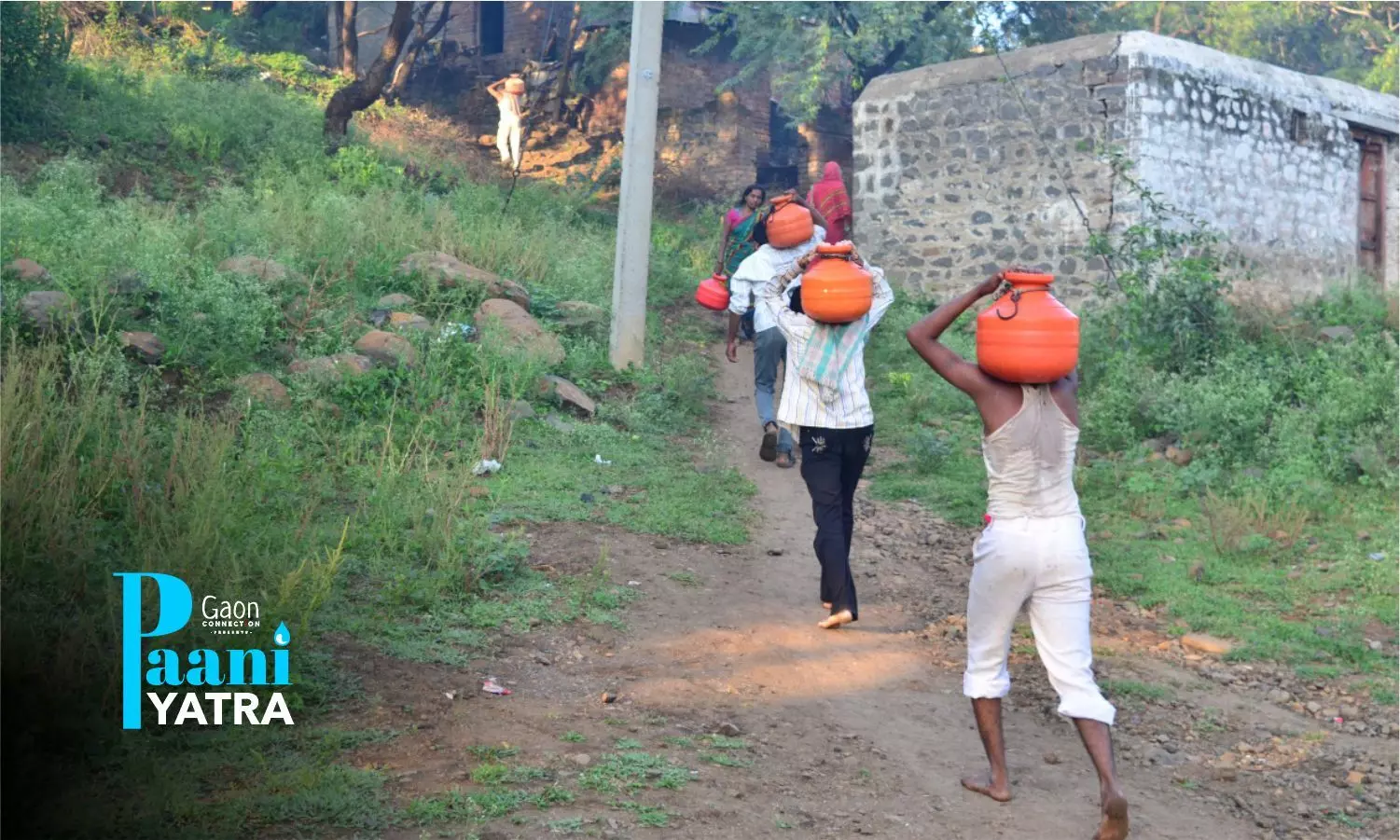
Millions of rural inhabitants are struggling to find water in the soaring temperatures. Photo: Abhishek Verma
In 2019, in a bid to lighten the water burden of rural women and girls who are often forced to walk several kilometres a day in the blistering heat to fetch water for their families, the central government launched the Har Ghar Jal scheme under the Jal Jeevan Mission. This central scheme promises to provide each and every rural household with a “functional tap water connection” in the next two years, that is by 2024.
Under the mission, drought-prone regions of Bundelkhand and Vindhyachal, spread across Uttar Pradesh and neighbouring Madhya Pradesh, have been identified as ‘priority’ and, as per the official announcement, villages in these areas would get their tap connections by the end of this year (2022).
हर घर जल पहुंचाना ही है सरकार का मुख्य उद्देश्य#HarGharJal #safedrinkingwater #SWSM #pipewatersupply pic.twitter.com/2O44Y8XpMg
— State Water & Sanitation Mission, Uttar Pradesh (@swsmup) July 22, 2020
As part of Gaon Connection’s new series – Paani Yatra – our national team of reporters and community journalists travelled to remote villages in different states of the country to document how rural citizens are meeting their water needs in the scorching summer and the heatwave conditions.
This story from Jhansi district in Bundelkhand region of Uttar Pradesh is the first in the series of Paani Yatra.
Rural women like the 45-year-old Poonam of Deli village spend almost half their day, every day, to fill and fetch water for their family. And the summer heat multiplies their woes manifold and messes with their health too.
Predictably, these women are acerbic. “We haul up water from wells, pump the handpumps, carry loads of water on our heads… There is neither a river nor any other safe water source. The facilities are pathetic here,” Poonam snapped on being asked how she meets the water needs of her family.
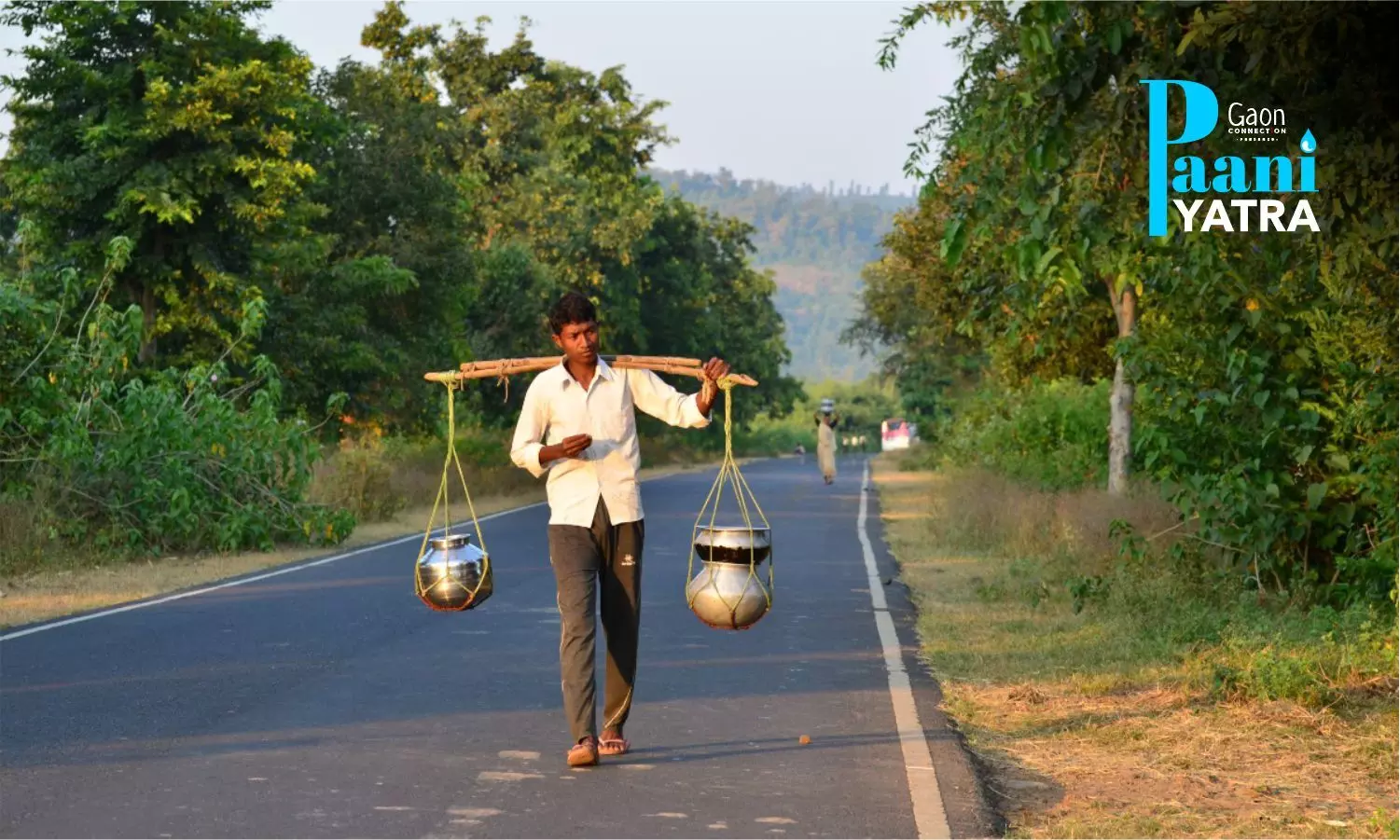
Villagers are often forced to walk several kilometres a day in the blistering heat to fetch water for their families. Photo: Abhishek Verma
Har Ghar Jal in Bundelkhand
According to the Jal Jeevan Mission, 49.42 per cent of rural households in the country have tap water connections. Uttar Pradesh has the lowest rural tap water coverage at 13.6 per cent, while states and Union Territories including Goa, Telangana, Andaman & Nicobar Islands, Haryana, Puducherry, Dadar and Nagar Haveli and Daman and Diu have 100 per cent tap water coverage.
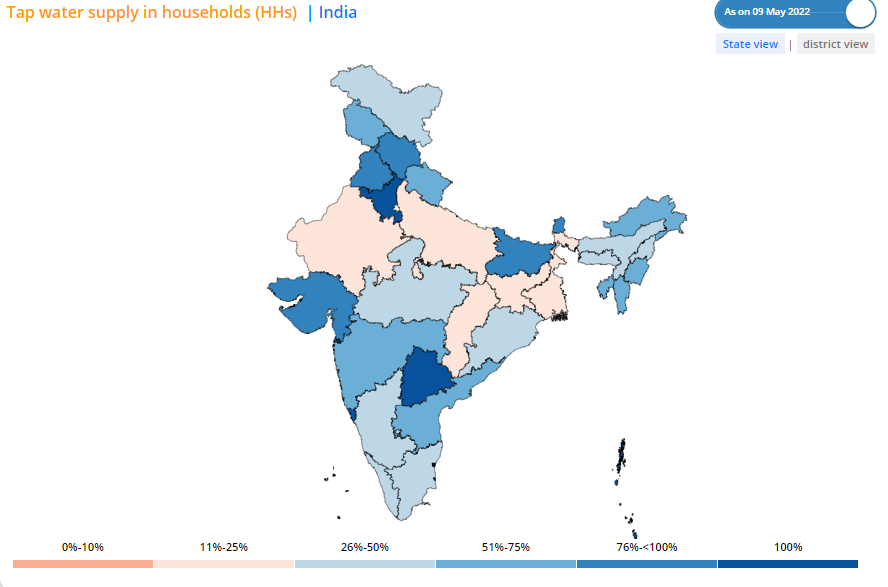
Rural tap water coverage in states/UTs as of May 9, 2022. Photo: ejalshakti.gov.in
Jhansi district along with 12 other districts in Uttar Pradesh and Madhya Pradesh that make up the Bundelkhand is in the news every summer as women in its rural areas trek long distances to fetch water.
Data from the Jal Jeevan Mission shows only 12.67 per cent of households in the rural areas of Jhansi district have tap water connections, as of May 4, 2022.
Meanwhile, all the seven districts of Bundelkhand region in Uttar Pradesh — Chitrakoot, Banda, Jhansi, Jalaun, Hamirpur, Mahoba, Lalitpur – have less than 20 per cent tap water coverage (see map: Tap water coverage in Bundelkhand). As per official communication, rural households in Bundelkhand region are expected to get tap water connections by this year end.
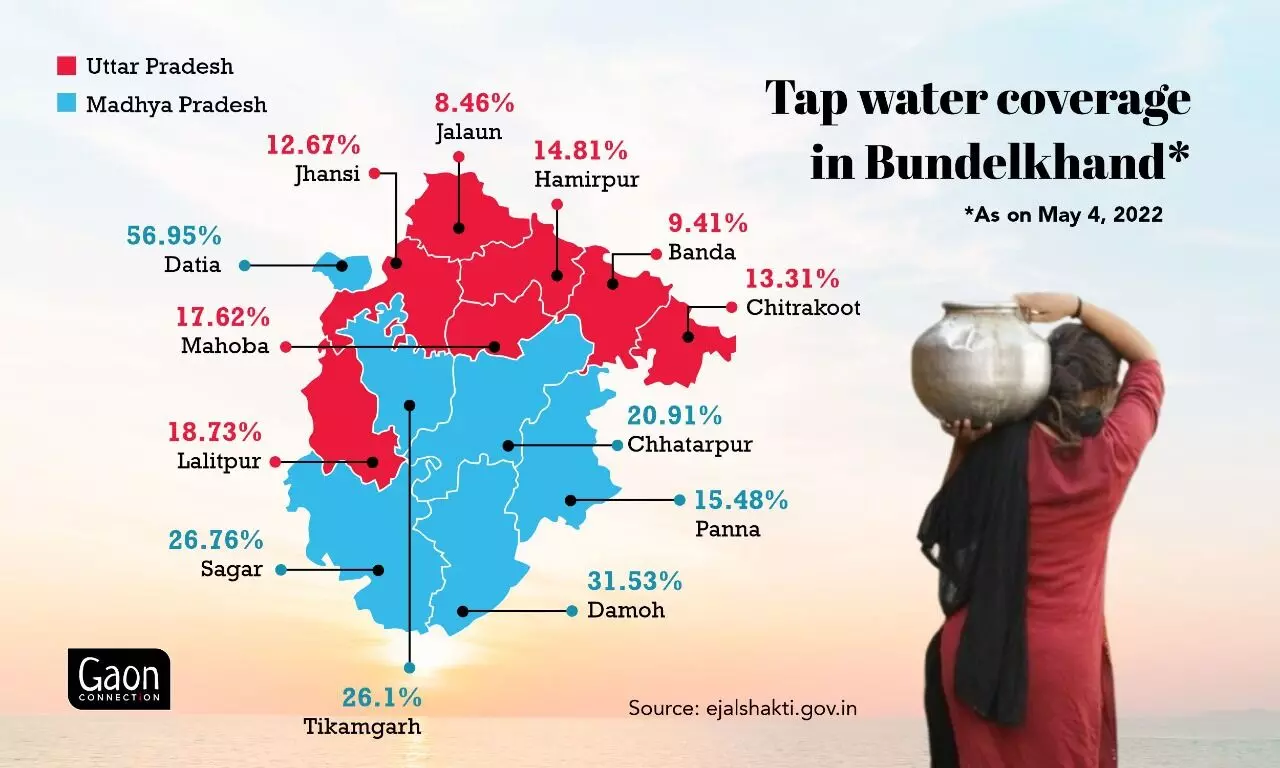
According to Uttar Pradesh Jal Shakti Minister Swatantra Dev Singh, the government aims to ensure full coverage of the drinking water supply scheme in Bundelkhand by November, this year.
During his visit to Mahoba and Hamirpur districts of Bundelkhand region last month in April, the minister had assured the six million people clean drinking water in the next six months. In Bundelkhand, 467 piped drinking water schemes are under construction under 32 projects of the Jal Jeevan Mission.
“Nearly 70 per cent work on Bundelkhand water projects is complete. People of Bundelkhand and Vindhya region, who have struggled for years for clean drinking water are going to get better water supply than expected,” the minister was quoted as saying.
District level officials are also confident. “I believe this (Har Ghar Jal) is a very krantikari (revolutionary) scheme, which will bring change in the lives of citizens. We will achieve the target [100 per cent tap water coverage by the end of 2022] on time,” Shailesh Kumar, chief development officer of Jhansi, told Gaon Connection.
“The population of Jhansi is about twenty lakhs (as per 2011 census) and there are four lakh households. We are trying to ensure that all households of Jhansi get piped drinking water,” the official said.
At present, about 83 per cent rural households in Jhansi district do not have piped water connections.
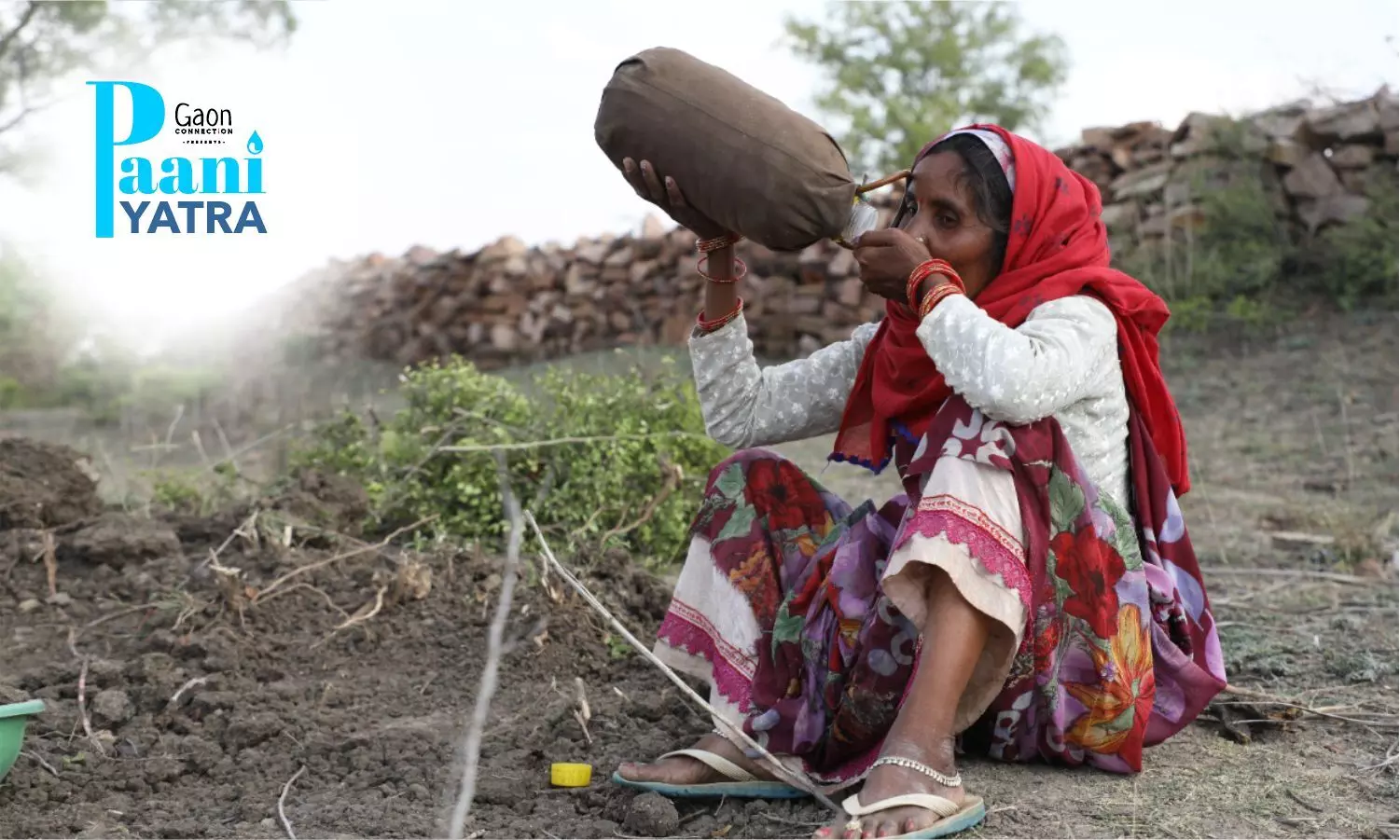
Rural India has always struggled for drinking water in the summers. Photo: Yash Sachdev
The dream vs reality: Taps sans water
Deli village in Jhansi too got the promised water taps. Only, there is no water in them.
“We got the government taps five or six months ago, yet we are forced to fetch water from outside. And, neither do we get water from private connections regularly,” Ankita, a Deli resident told Gaon Connection.
According to her, there were daily fights over the water that flowed intermittently, and when it did the quality of the water was so bad that it could only be used to flush toilets. “We cannot drink it,” the 21-year-old said as she kept her eye on the community tap, willing it to start dispensing water.
“The summer has brought with it power cuts and if there is no power, there is no water. And, on such days we go to roadside tanks to get it. We complain about it, some officials visit us and nothing else ever happens,” she added.
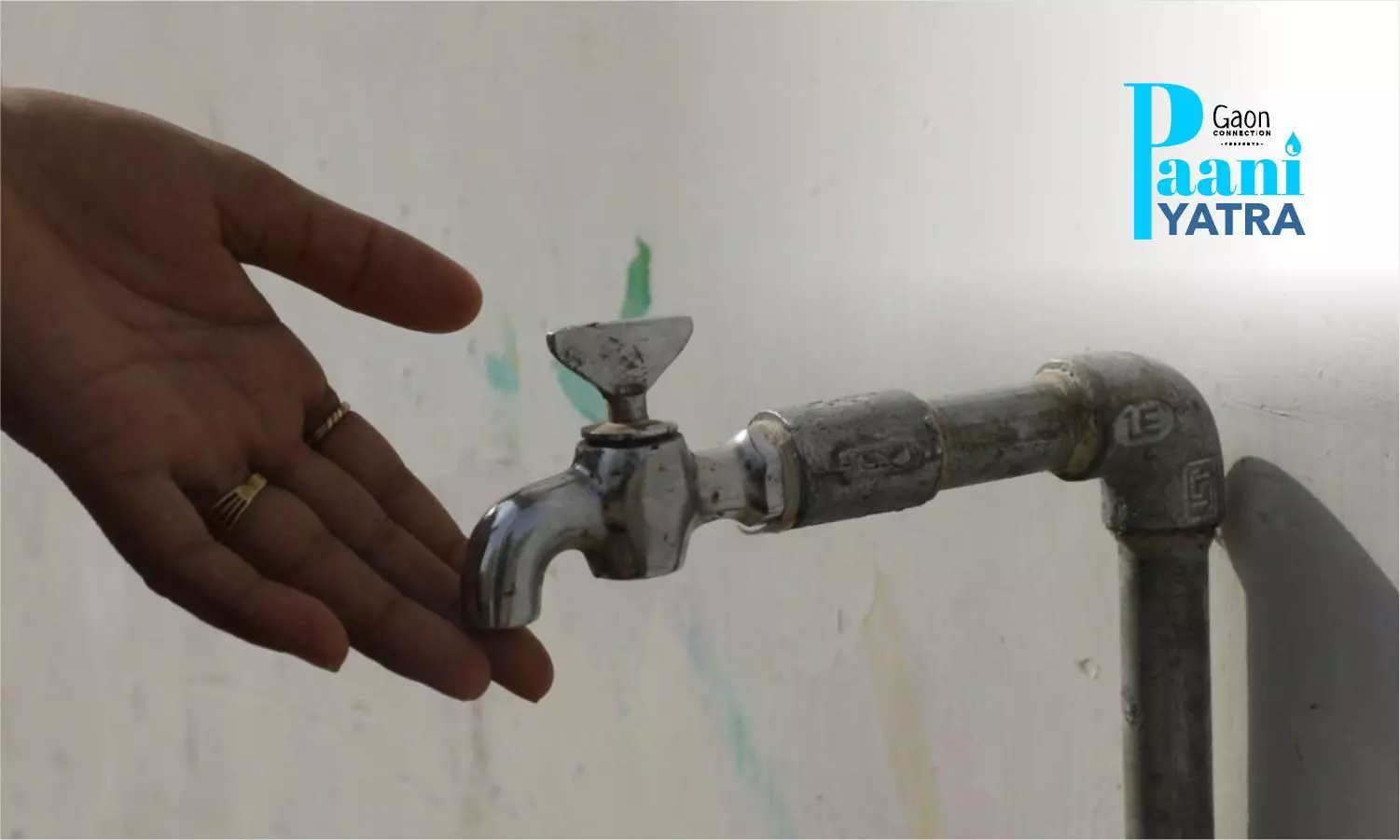
Ankita checking the tap water connection provided to her household by the government. Photo: Yash Sachdev
Similar complaints poured in from the Simrawari village. “Last year pipelines were laid down but we could get water for only a month,” Paras Lodhi, a resident of the village told Gaon Connection. “We now fetch water from a kilometre on our cycles. We do this at least ten times a day. We have to get water for ourselves and our cattle. Wells here are dirty and full of insects; our children get sick after drinking that water,” he added.
“At times, we have to buy water from private water tankers for hundred rupees and it lasts for two days only,” added the 32-year-old.
In the scorching summer heat, with temperatures crossing 45 degree Celsius, bicycles are coming to the rescue of several villagers who are using them to carry water and reduce their daily drudgery.
“In a day I have to make six rounds of the handpump, which is half a kilometre away. I can only carry four dabbey (buckets) at a time in my cycle,” 42-year-old Harwaan, who hails from Sarwa village of Jhansi, told Gaon Connection. He informed that he has a government tap connection at his home but there is no water in it.
Shailesh Kumar, the chief development officer, Jhansi, clarified: “Intake wells are under construction from which the water ultimately goes to the taps… the intake wells and pipelines would be complete by July this year. Only then will the water come out through the taps.” The official went on to add that “10 projects were happening even as we speak in Jhansi, through which we will provide tap water.”
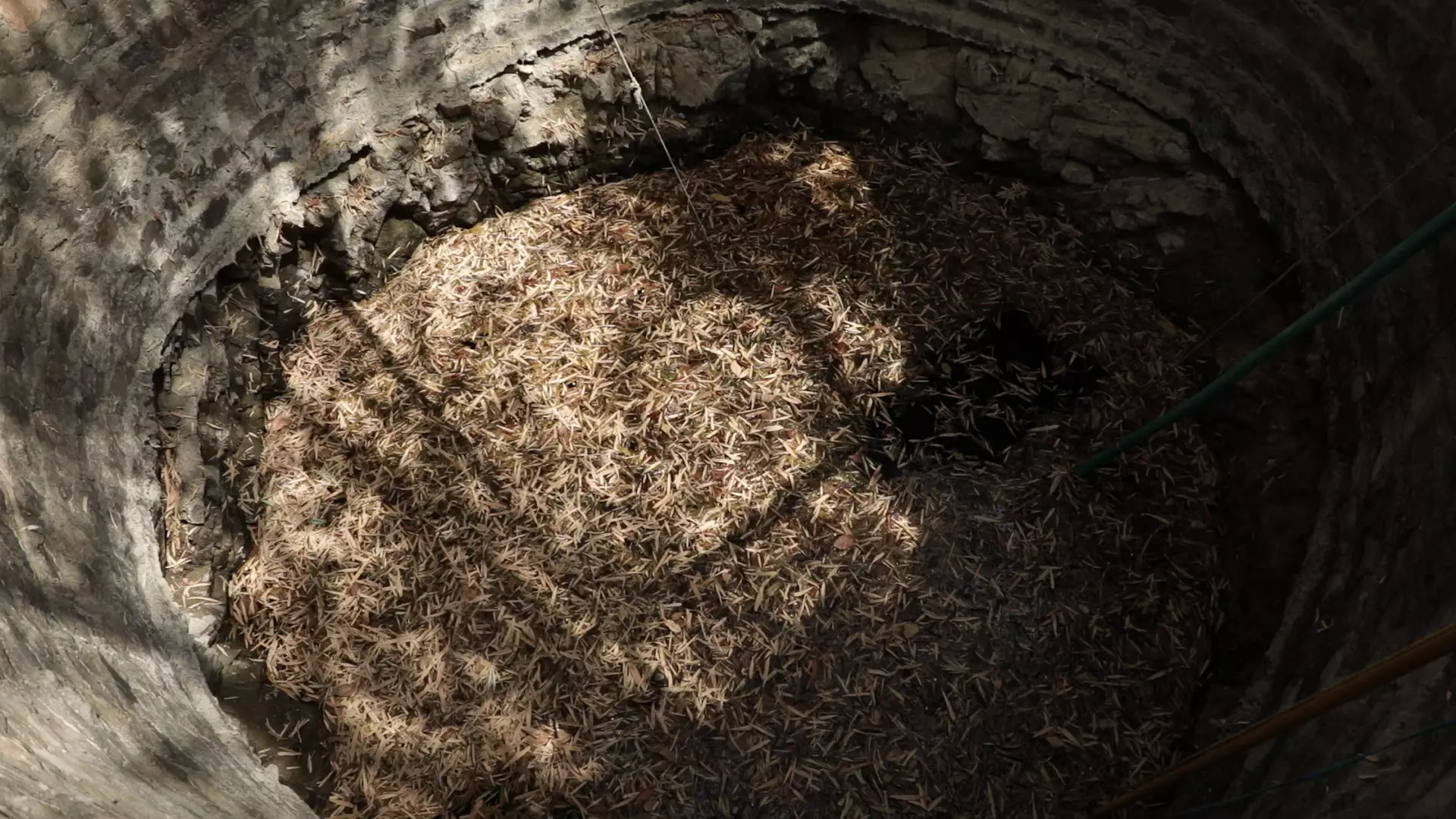
Villagers are dependent on dirty well for drinking purposes. Photo: Yash Sachdev
The story of dry taps – narrow pipes
On being questioned why their recently installed taps were dry, villagers and the gram pradhan (village head) of Deli said the pipelines were too small and the terrain too uneven for the water to flow smoothly from the government installed taps.
“Engineer sahab of Jal Sansthan told us that the pipeline will be changed as it is too narrow. The main tank is six kilometres away from here so more pressure is needed if the water has to reach the taps,” Dasrath Ahirwar, the village head, told Gaon Connection.
“Dirty water must have choked the pipes. For now, I have arranged for private water taps connected to the nearby well,” he added.
According to Umesh Narain Srivastava, another villager from Deli, “Flow and pressure in government taps is not enough. Households that are situated at lower elevation might get water but those at higher elevations do not get water. Levelling is important,” he said. Besides, the government taps provide water only once in ten or twelve days, the villager told Gaon Connection.
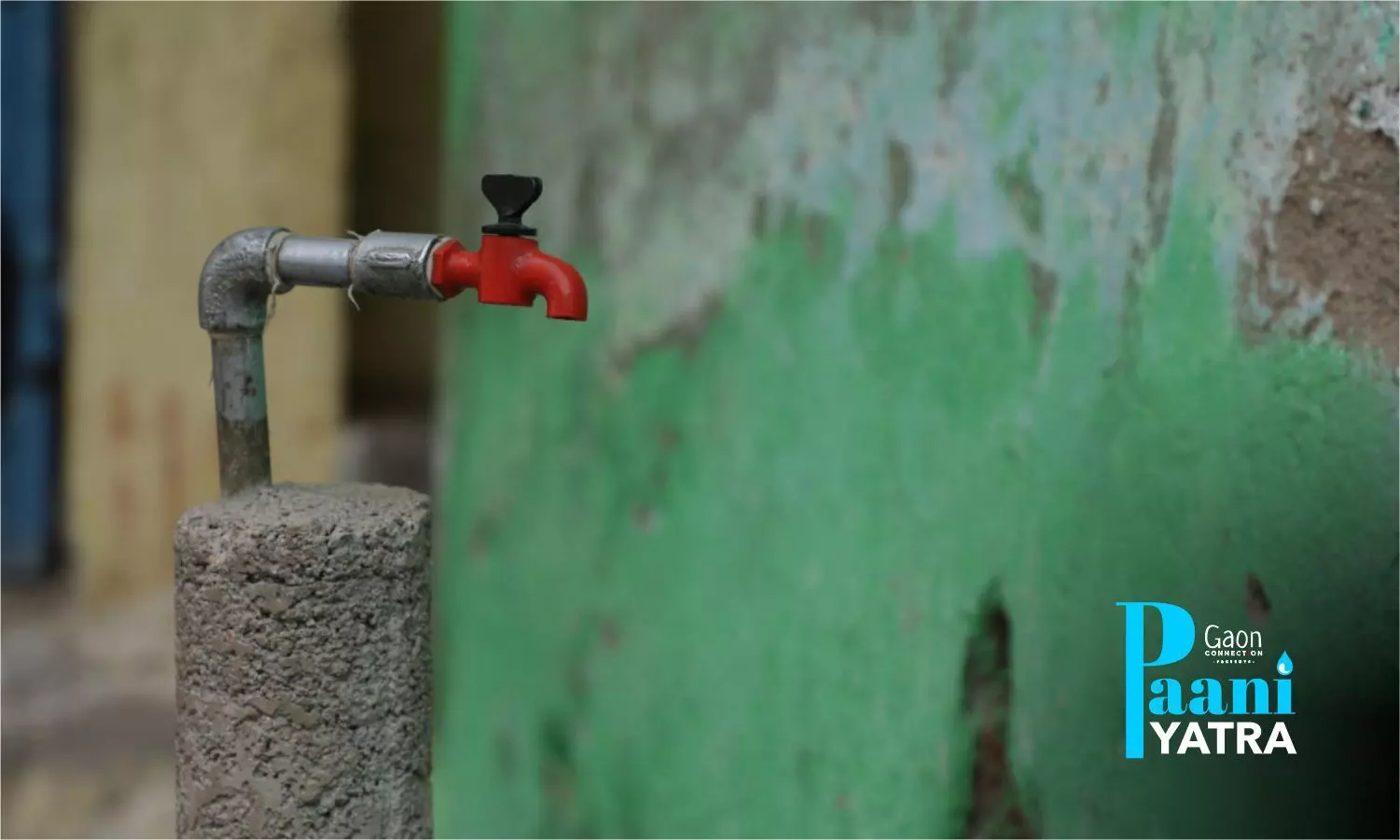
At present, about 83 per cent rural households in Jhansi district do not have piped water connections. Photo: Yash Sachdev
Paying for private water supply
When the government proved unequal to solve the water crisis, the women of Deli village pooled in money to get private water connections in the community. Water is sourced from a nearby open well (it was covered with dirt and dry leaves when Gaon Connection visited the village on April 19), and the motor draws water from the dirty well. There is no system to filter the water and villagers drink it.
“We all ladies collected money to install private tap connections. Some gave fifty rupees, some hundred. We are now paying to get water. It has been only a month. Earlier, we would fetch water from wells. Thankfully, the village dugwell does not dry up, even in hot summers,” said Poonam.
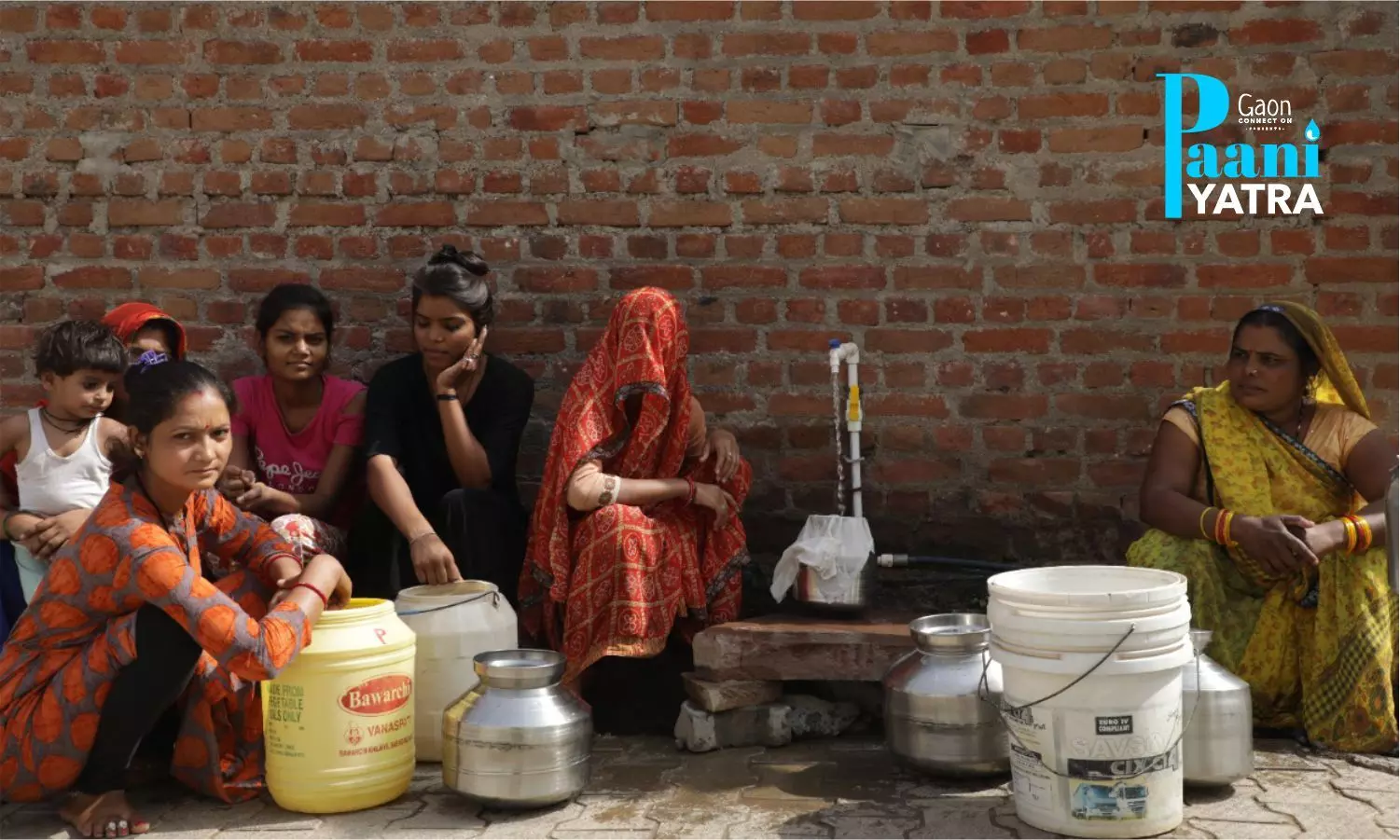
For the 120 odd households in Deli, 22 community tap connections have been installed and divided between two lines, to supply water from 7 to 12 in the morning in one line, and 2 pm to 6 pm in the evening in the other line. At least 10 households fill water from one tap at a time, informed Umesh Kumar Narain, who has been elected by the village women to manage their private water connections. Each household pays him Rs 100 a month.
“When there is no electricity in the day, I go door to door and wake people at two or three in the morning so that they fill their water buckets, when the power is restored,” said Srivastava.
The quality of water remains a big issue in Uttar Pradesh. In several districts water is contaminated by arsenic, fluoride and iron, which cause serious health problems including cancer (arsenicosis). Almost 18 districts, including Jhansi, have both high arsenic and fluoride in their groundwater (see map: Arsenic and fluoride affected districts in Uttar Pradesh (2019 data)).
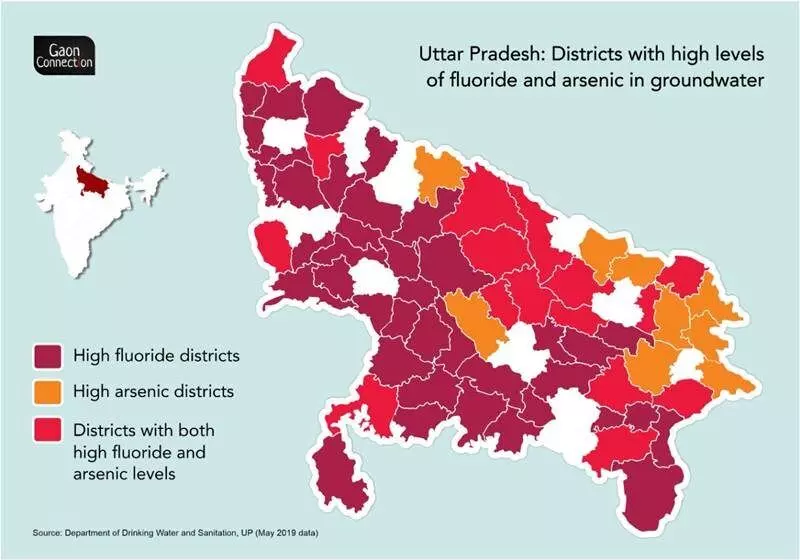
Unutilised funds under Jal Jeevan Mission
The Indian government is implementing the Jal Jeevan Mission in partnership with states and Union Territories to provide potable tap water supply on regular and long-term basis to every rural household of the country by 2024.
State-wise data shows Uttar Pradesh was allocated Rs 1,206.28 crores, of which 53 per cent (639.32 crores) were utilised in the FY 2019-20 under the Jal Jeevan Mission for the project implementation.
For FY 2020-21: Rs 2,570.94 crores were allocated, out of which 68.5 per cent (Rs 1,761.06 crores) were utilised.
For FY 2021-22: Rs 10,870.50 funds that were allocated to Uttar Pradesh, 27 per cent or Rs 2,930.07 crores (till April 4) were utilised for the provision of functional tap connections in the state.
This data was shared by the Minister of State for Jal Shakti Prahlad Singh Patel in Lok Sabha last month on April 7. Gaon Connection got it confirmed by Priya Ranjan Kumar, Finance Controller, State Water & Sanitation Mission, Namami Gange and Rural Water Supply Department, Government of Uttar Pradesh.


